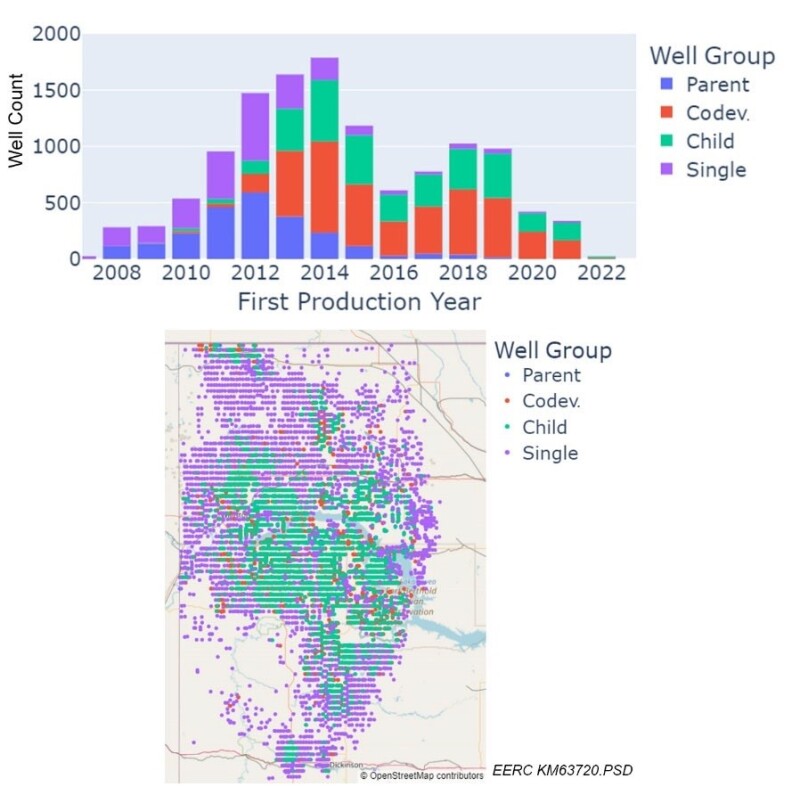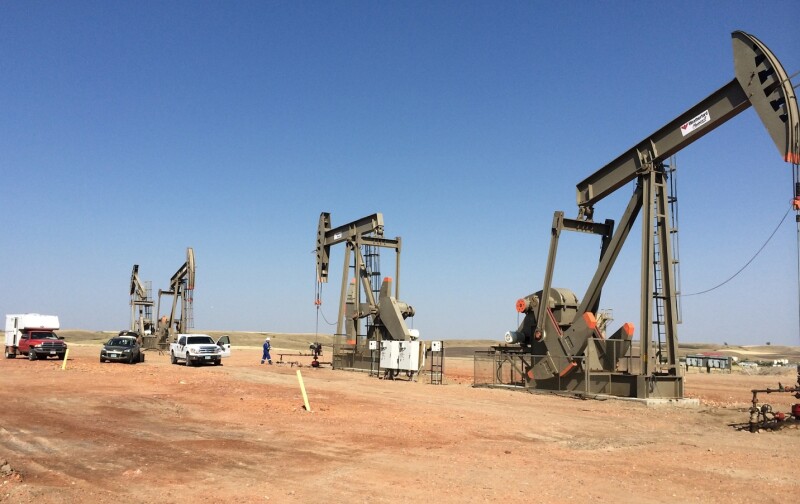Well-to-well interactions in North Dakota鈥檚 Bakken Shale stand out in one big way from those in most other unconventional plays. Whereas frac hits generally hurt production in older parent wells elsewhere, they often improve it in Bakken.
Over the years, the question has lingered鈥攚hy?
One theory suggests that the Bakken's unique geologic properties, particularly its proclivity for long planar fractures, is responsible. And there may very well be a geologic linkage, but new research shared at the recent Unconventional Resources Technology Conference (URTeC) argues that there is a little more to the story.
Kyoung Suk Min of the Energy and Environmental Research Center (EERC) in North Dakota elaborates: 鈥淭he reason why Bakken operators have historically not seen much production loss from the parent-child effect is because their initial completion designs were small, suboptimal, and understimulated.鈥�
Min, a reservoir engineer and data scientist, along with his EERC colleagues, authored the conference paper URTeC 3862589 which concluded that understimulated wells are the chief driver of beneficial frac hits in the Bakken. The research team used machine learning models to analyze data from over 17,000 horizontal wells, nearly half of which were determined to have been impacted by parent-child interactions.
Among the study鈥檚 biggest insights is that the most beneficial frac hits were seen in parent wells with proppant loadings of less than 450 lb per lateral ft鈥攁nd that 83% of all parent wells in the Bakken fall below this critical threshold.
Then there is the other side of the equation. The EERC found that when a child well鈥檚 proppant loading surpassed 1,000 lb/ft, the adjacent parent wells saw production surge by an average of 123% over the 90-day post-stimulation period.
Others have looked at the issue and suggested a similar link. In URTeC 3868861, also published this year, authors from the University of Wyoming and Texas A&M University examined a smaller subset of parent-child wells that showed clear signs of fracture interactions.
While noting that most of the wells analyzed did not show a 鈥渟trong correlation,鈥� the researchers highlighted that the lower a parent well鈥檚 initial production rate, the higher it鈥檚 post-frac-hit production tended to be. 鈥淭his can be explained in terms of stimulating the parent wells which were potentially understimulated prior to [a] child鈥檚 completion.鈥�

当时我们不知道的事情
EERC 发现,巴肯的大部分未受刺激的母井均在 2010 年至 2015 年期间完工,Min 表示,这代表了该地区井设计普遍停滞的时期。
在此期间,典型的支撑剂负载量为 200 至 400 磅/英尺。到 2016 年,平均数字飙升至 900 磅/英尺以上,并且至今仍保持在该水平。
额外的背景是,巴肯是十年前第一个取得重大发展的致密油区,这意味着它的第一批勘探者在攀登学习曲线时处于不利地位。
Min 将这一点与其他地方分享的经验进行了对比,并指出,“如果你看看二叠纪或其他盆地,母井的初始完井规模更大,它们更接近巴肯新子井的样子。” �
这提出的一个观点是,随着刺激不足的母井数量持续减少,而新的母井供应短缺,因为它们可能正在使用更大的增产设计,因此提高产量的压裂打击将很快成为过去。 。
是的,井间距也很重要
除了支撑剂用量之外,井距是决定井间相互作用程度的另一个关键因素。EERC 分析表明,随着井间距降至 800 英尺以下,相互作用会变得更强,子井生产力的风险也会增加。
为了说明这一点,EERC 假设,巴肯的一口子井以 1,300 磅/英尺的泵压并降落在距离母井 400 英尺的地方,在其使用的第一年将遭受 40,000 桶的产量缺口。
该地区作业者的应对措施是远离母井,同时为子井配对保留紧密的间距。EERC 显示,目前亲子间的平均间距略高于 700 英尺,而儿童井的平均间距接近 580 英尺。
重新思考重复压裂
研究结果的另一个含义涉及巴肯运营商重复压裂的未来。一些作业者正在转向重复压裂母井,作为对母井的保护措施,同时也是对需要裂缝来打开新岩石的子井的保护措施。
然而,EERC 报告的结果并不意味着出于缓解原因对这种做法的强烈认可。他们认为重复压裂可以成为一种缓解工具,但仅限于井距相对较小的情况,即使如此,净影响也可能不会令人印象深刻。
根据该论文:“在与重复压裂母井相互作用的子井中,当井距范围从小于 400 英尺到大于 1,200 英尺时,子井产量影响范围分别为 9% 到 +5%。相比之下,在没有重复压裂母井的子井中,当井距范围从小于 400 英尺到大于 1,200 英尺时,子井产量影响范围分别为“15.4%至+0.6%”。
敏补充说,数据显示,重复压裂作为一种保护措施具有“一定但不是很多”的价值。
EERC 正在继续研究这一方面和其他方面,因为重复压裂有望在老化致密岩储层的未来中发挥重要作用。
供进一步阅读
URTeC 3862589巴肯亲子互动因果关系的数据驱动分析,作者:Kyoung Suk Min、Alexander V. Chakhmakhchev、Xue Yu、Nicholas A. 等人,能源与环境研究中心。
URTeC 3868861裂缝驱动相互作用对威利斯顿盆地母井和子井产量影响的识别和量化,作者:Abdeldjalil Latrach,怀俄明大学;艾哈迈德·梅尔祖格 (Ahmed Merzoug),德克萨斯农工大学;和 Cilia Abdelhamid 等人,怀俄明大学。
